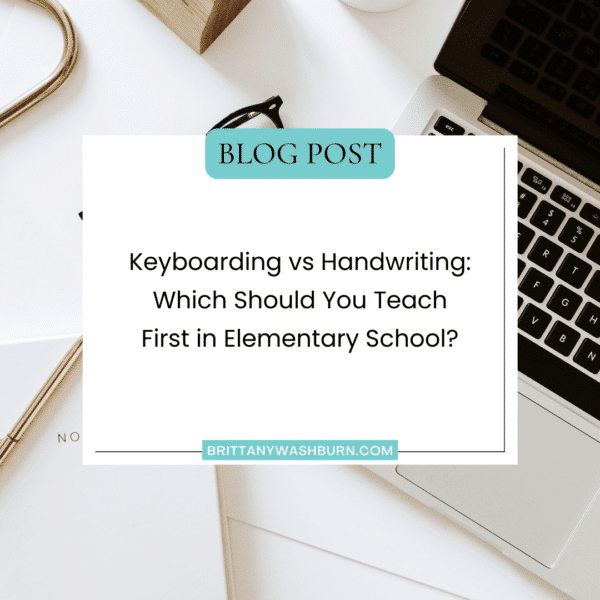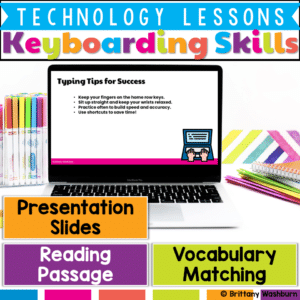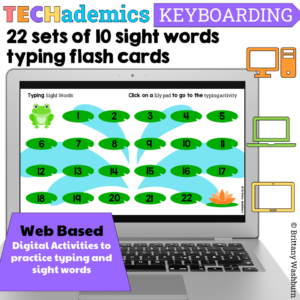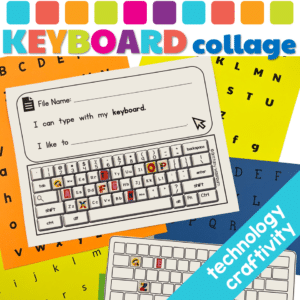Keyboarding vs Handwriting: Which Should You Teach First in Elementary School?

Teaching keyboarding and handwriting skills in elementary schools has become increasingly important. However, the debate on which to teach first is still ongoing. While some argue for the importance of mastering the traditional skill of handwriting, others claim that keyboarding skills are more practical and necessary in today’s society. In this article, we will explore the advantages and disadvantages of teaching each skill first, as well as strategies for combining handwriting and keyboarding instruction in the classroom. Additionally, we will provide practical tips for effectively teaching both skills to young learners, so that educators can make informed decisions about which approach is best for their classrooms.
Introduction: The Debate on Keyboarding vs Handwriting in Elementary School
In an era where technology dominates most aspects of our lives, there has been a heated debate on whether to teach handwriting or keyboarding first in elementary schools. While handwriting has been the traditional mode of writing, keyboarding is increasingly becoming relevant in today’s technologically driven society. Both handwriting and keyboarding have their unique advantages and disadvantages, which makes it difficult to choose which one to teach first. In this article, we will explore the importance of handwriting and keyboarding skills in the 21st century, their advantages, disadvantages, and the challenges associated with teaching them.
The Importance of Handwriting and Keyboarding Skills in the 21st Century
How Technology is Changing Writing and Learning
Technology has changed the way we communicate, learn and work. In today’s digital world, writing has gone beyond pen and paper to include typing on a keyboard or touchscreen. The increased use of computers, smartphones, and tablets in schools and workplaces has made keyboarding skills more critical than ever.
The Cognitive Benefits of Handwriting
Handwriting, on the other hand, has its unique cognitive benefits. Research has shown that engaging in handwriting exercises improves brain development in children and enhances their fine motor skills. Additionally, writing by hand helps with retention and comprehension of information learned in class, which is particularly critical in elementary school when students are still learning foundational skills.
The Practical Benefits of Keyboarding
While handwriting has its cognitive benefits, keyboarding has its practical advantages. Firstly, it’s faster and more efficient than handwriting, which is particularly useful for older students who need to take notes quickly. Keyboarding also reduces the physical stress associated with handwriting, such as cramping and fatigue.
Advantages and Disadvantages of Teaching Handwriting First in Elementary School
The Case for Handwriting Instruction
Many educators argue that teaching handwriting first in elementary school is critical because it builds essential foundational skills that students will need throughout their academic careers. For example, handwriting helps children develop their fine motor skills, improve their hand-eye coordination, and build muscle memory. Handwriting instruction also encourages students to think more critically about the language, spelling, and grammar they’re using.
The Challenges of Handwriting Instruction
The primary challenge of teaching handwriting is that it’s time-consuming, and not all students find it engaging. Additionally, it can be challenging to assess students’ progress in handwriting skills, which can make it difficult to determine the effectiveness of instruction.
Advantages and Disadvantages of Teaching Keyboarding First in Elementary School
The Case for Keyboarding Instruction
Teaching keyboarding first in elementary school has become increasingly popular due to the practical advantages it offers. For example, typing is faster and more efficient than handwriting, which can be valuable when students need to take notes quickly. Keyboarding is also an essential skill for future careers, particularly those that require working with computers or technology.
The Challenges of Keyboarding Instruction
One challenge of teaching keyboarding is that it can be less engaging than handwriting instruction for some students. Additionally, students may struggle with developing proper typing techniques, which can lead to physical discomfort and repetitive strain injuries. Finally, keyboarding instruction can be expensive if schools need to purchase new computers or software to teach the skill effectively.
In conclusion, the debate of whether to teach handwriting or keyboarding first in elementary school is complex. Both skills have unique advantages and disadvantages, and educators must weigh up the pros and cons before deciding which to teach first. Ultimately, the decision should be based on the needs of the students, the goals of the curriculum, and the resources available to the school.
Combining Handwriting and Keyboarding Instruction in Elementary School
In today’s digital age, it’s important for children to develop both typing and handwriting skills. While some argue that keyboarding should be taught first, others believe that handwriting should be prioritized. The truth is, both skills are equally important, and a balanced approach to instruction is key.
The Benefits of a Balanced Approach
Teaching both typing and handwriting in elementary school can provide children with significant benefits. Research has shown that learning to write by hand improves cognitive skills such as memory retention and critical thinking. Additionally, mastering typing skills can increase efficiency and productivity in the classroom and beyond.
How to Integrate Handwriting and Keyboarding Instruction
A balanced approach to instruction can be achieved through a variety of classroom activities. For example, teachers can incorporate typing and writing exercises into their lessons, encourage students to take notes by hand and use word processing software for written assignments. It’s important to remember that each child learns at their own pace, so offering individualized instruction can also be beneficial.
Practical Tips for Teaching Handwriting and Keyboarding in Elementary School
Effective Handwriting Teaching Strategies
When teaching handwriting, it’s important to start with the basics such as proper grip and posture. Teachers can also use a variety of teaching strategies such as modeling, tracing, and copying. It’s important to make handwriting lessons interactive and fun to keep children engaged.
Effective Keyboarding Teaching Strategies
To be an effective typist, children must first master the keyboard. Teachers can start by introducing students to the home row keys and gradually building speed and accuracy. Typing games and exercises can also be helpful in making keyboarding lessons more engaging.
Conclusion: Choosing the Right Approach for Your Classroom
When it comes to teaching typing and handwriting in elementary school, a balanced approach is ideal. By providing children with instruction in both skills, educators can prepare them for success both in and out of the classroom. Whether you choose to teach handwriting or keyboarding first, remember that each child learns at their own pace, and offering individualized instruction can make all the difference.
Both handwriting and keyboarding skills are essential for success in the 21st century. It is important for educators to find a balance between traditional writing and digital skills in their instruction, and to provide students with the tools they need to excel in both areas. By using the strategies and tips outlined in this article, teachers can help their students develop the necessary skills to navigate the ever-changing landscape of communication and technology.

FAQ
Which skill should be taught first in elementary school: handwriting or keyboarding?
There is no one-size-fits-all answer to this question. The decision on which skill to teach first should be based on the needs and objectives of individual classrooms. Teachers should consider the benefits and challenges of teaching each skill, as well as the needs and interests of their students.
Is handwriting still relevant in today’s digital age?
Yes, handwriting is still relevant in today’s digital age. Handwriting has been shown to have cognitive benefits, such as improving memory and critical thinking skills. Additionally, it is important for students to develop legible handwriting for tasks such as taking notes and filling out forms.
Is there a recommended age for when to start teaching keyboarding skills?
It is recommended to start teaching keyboarding skills in late elementary or early middle school, around grades 4-5. However, this can vary depending on the student’s individual needs and abilities.
How can teachers effectively teach both handwriting and keyboarding skills?
Teachers can effectively teach both skills by integrating them into their curriculum in a balanced and meaningful way. This can include activities such as journaling, note-taking, and typing assignments. Additionally, teachers can incorporate games and activities that promote both handwriting and keyboarding skill development.

Read a related post or check out some other keyboarding resources below:
Typing Olympics – 3rd Grade Keyboarding Bootcamp
How do you teach keyboarding skills? While I have kindergarten and first graders use the…
Text Formatting Freebie
Text formatting is a great way to help students master word processing. Featuring two technology…
The Importance of Keyboarding in Kindergarten
As the world becomes increasingly digital, it’s essential to equip our youngest learners with the…
Why Do Elementary Students Need to Learn Computer Keyboarding?
Keyboarding skills are essential for success in both academic and professional settings. Elementary students may…
How to Manage a Typing Competition in the Computer Lab
Thinking about running a typing competition in your computer lab? It’s actually a great way…
How to Integrate Keyboarding Lessons into your Curriculum
As educators, it is important to recognize the importance of keyboarding skills and integrate them…























